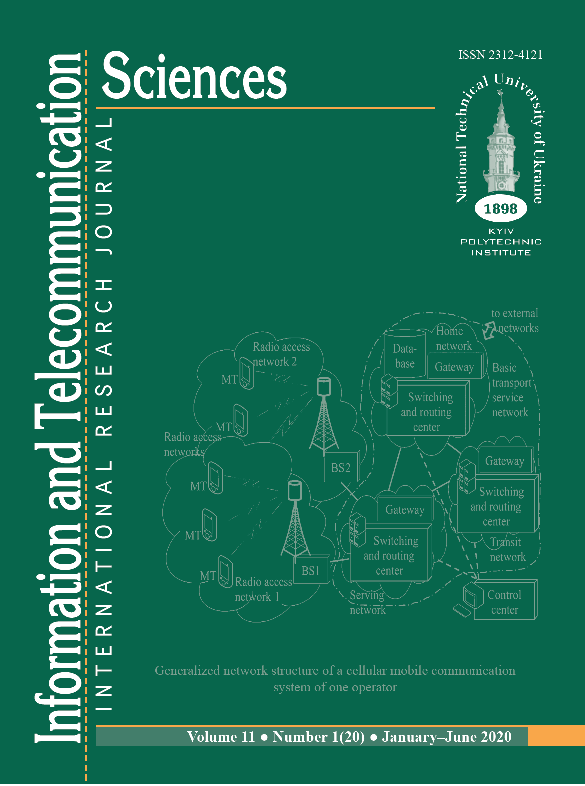DEVELOPING A COMPUTER VISION RE-IDENTIFICATION SYSTEM
DOI:
https://doi.org/10.20535/2411-2976.12020.35-40Keywords:
machine learning, video surveillance, re-identification, computer vision, deep learningAbstract
Background. The rapid growth of computational power of machines and amount of data caused exploding usage of computer vision in a large variety of tasks and in particular for people recognition.
Objective. The aim of the paper is to propose a computer vision re-identification system based on research. Also improvements for detection and recognition models of the system are made.
Methods. We used classical computer vision and deep learning techniques to create the system.
Results. The main contribution of the research is a description of the optimal system structure with a trade-of between speed and quality. Furthermore, requirements for an environment are proposed, which allows to set up the system in the real world with guaranteed quality.
Conclusions. Real-time computer vision re-identification system was developed and can be used in a production environment which satisfy requirements.
References
Kaiming He, Xiangyu Zhang, Shaoqing Ren, Jian Sun
“Deep 1Residual Learning for Image Recognition”.
arXiv:1512.03385, 2015.
Andrew G. Howard, Menglong Zhu, Bo Chen, Dmitry
Kalenichenko, Weijun Wang, Tobias Weyand, Marco
Andreetto, Hartwig Adam “MobileNets: Efficient
Convolutional Neural Networks for Mobile Vision
Applications”. arXiv:1704.04861, 2017.
Joseph Redmon, Santosh Divvala, Ross Girshick, Ali
Farhadi “You Only Look Once: Unified, Real-Time Object
Detection”. arXiv:1506.02640, 2015.
Wei Liu, Dragomir Anguelov, Dumitru Erhan,
Christian Szegedy, Scott Reed, Cheng-Yang Fu, Alexander C.
Berg “SSD: Single Shot MultiBox Detector”.
arXiv:1512.02325, 2016.
E. Bochinski, V. Eiselein, T. Sikora. High-Speed
Tracking-by-Detection Without Using Image Information. In
International Workshop on Traffic and Street Surveillance for
Safety and Security at IEEE AVSS 2017, 2017.
Hamed Kiani Galoogahi, Ashton Fagg, Simon Lucey
“Learning Background-Aware Correlation Filters for Visual
Tracking”. arXiv:1703.04590, 2017.
Yandong Wen, Kaipeng Zhang, Zhifeng Li and Yu
Qiao. A Discriminative Feature Learning Approach for Deep
Face Recognition. The Chinese University of Hong Kong, Sha
Tin, Hong Kong, 2016.
Jiankang Deng, Jia Guo, Niannan Xue, Stefanos
Zafeiriou “ArcFace: Additive Angular Margin Loss for Deep
Face Recognition” arXiv:1801.07698, 2018.
Yu. A. Malkov, D. A. Yashunin “Efficient and robust
approximate nearest neighbour search using Hierarchical
Navigable Small World graphs”. arXiv:1603.09320, 2016.
Sanghyun Woo, Jongchan Park, Joon-Young Lee, In
So Kweon “CBAM: Convolutional Block Attention Module”.
arXiv:1807.06521, 2018.
Downloads
Published
How to Cite
Issue
Section
License
The ownership of copyright remains with the Authors.
Authors may use their own material in other publications provided that the Journal is acknowledged as the original place of publication and National Technical University of Ukraine “Igor Sikorsky Kyiv Polytechnic Institute” as the Publisher.
ITS articles are published under Creative Commons licence:
- Authors retain copyright and grant the journal right of first publication with the work simultaneously licensed under CC BY 4.0that allows others to share the work with an acknowledgement of the work's authorship and initial publication in this journal.
- Authors are able to enter into separate, additional contractual arrangements for the non-exclusive distribution of the journal's published version of the work (e.g., post it to an institutional repository or publish it in a book), with an acknowledgement of its initial publication in this journal.
- Authors are permitted and encouraged to post their work online (e.g., in institutional repositories or on their website) prior to and during the submission process, as it can lead to productive exchanges, as well as earlier and greater citation of published work.

